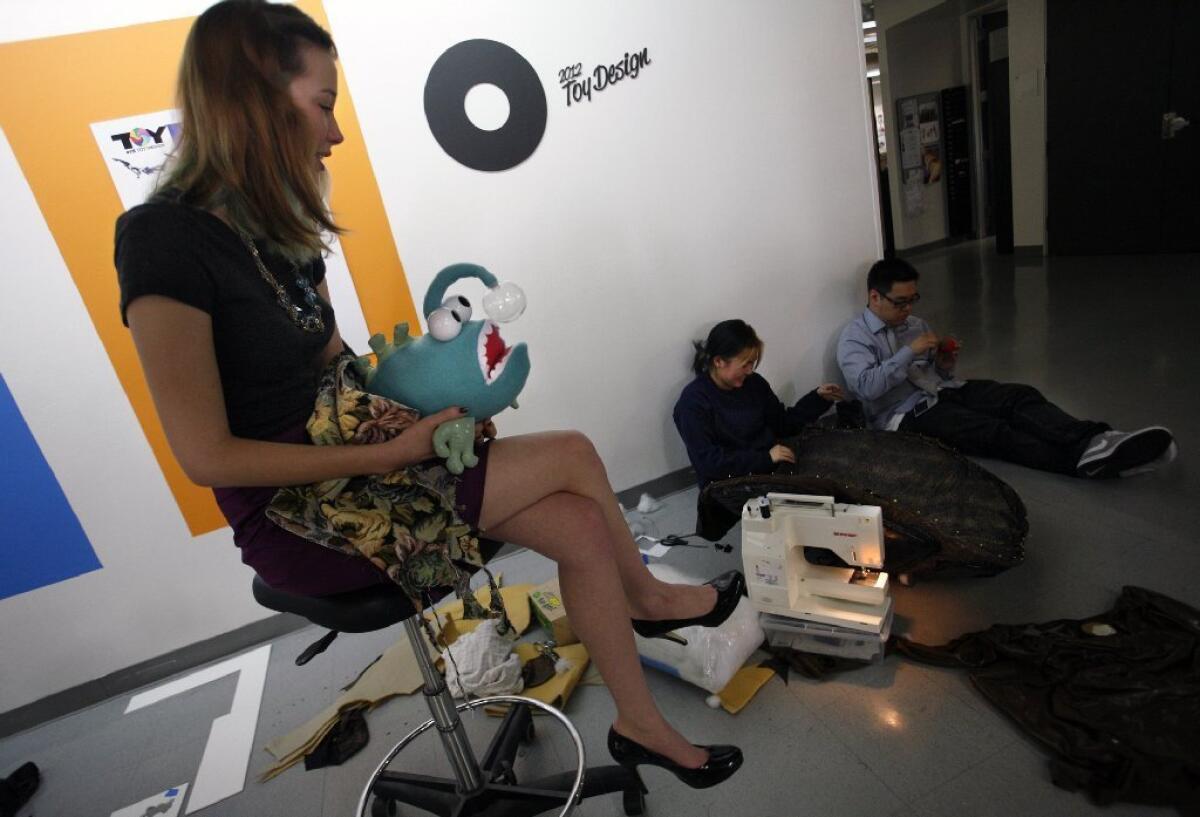State’s creative jobs paying well but less plentiful, report says

Mamas, do let your babies grow up to be creative types -- preferably with skills that would appeal to an Internet company or a software publisher, since, on average, people who design video games and online apps and the like make more money than people who take bows on stages, play roles on screens or write the lines actors deliver.
That, with apologies to Waylon Jennings and Willie Nelson, is the gist of the latest annual Otis Report on the Creative Economy, commissioned by L.A.’s Otis College of Art and Design and prepared by the Los Angeles County Economic Development Corp.
The new edition, issued Thursday and crunching employment figures for 2012, for the first time addresses how the arts and culture and related industries affect the economy statewide.
PHOTOS: Arts and culture in pictures by The Times
In a nutshell, Internet publishing and digital media boomed in the five years from 2007 to 2012, and everything else was an also-ran, at best.
Since debuting in 2008, the Otis Report had focused only on Los Angeles County and Orange County. The expanded statistical reach comes courtesy of the California Arts Council, state government’s meagerly funded arts grant-making agency, which kicked in $50,000 to extend the study statewide.
The arts council’s budget was eviscerated by California elected officials in the early 2000s and has been left to languish ever since. Arts advocates hope that legislators and Gov. Jerry Brown will restore funding after perusing the 150-page Otis Report.
CRITICS’ PICKS: What to watch, where to go, what to eat
Brown’s latest budget proposal would allocate the arts council’s standard $1 million from state tax coffers, which is more or less matched by the federal government. Private donations, primarily from California motorists who opt to pay extra for special arts supporter license plates, figure more heavily than taxpayer funds in the agency’s $5-million annual budget. California perennially ranks 48th to 50th in the nation in per-capita funding of its state arts agency.
Arts advocates’ push for more money is scheduled to begin Feb. 12, when state Sen. Ted Lieu (D-Torrance) will convene a legislative hearing on the new Otis Report in Sacramento.
The report lays out how many people work in creative fields, what they earn, how they fare compared to other occupations, and what that means to Californians’ wallets and employment possibilities.
PHOTOS: The most fascinating arts stories of 2013
The ammo for arts advocates includes a finding that California’s 681,400 creative workers, broadly defined, earned an average annual wage of $90,130 during 2012 -- 37.5% higher than the average statewide wage of $56,293.
The figures don’t include self-employed workers, only those who work for someone else. For the report’s purposes, if you work in a furniture or apparel factory, man a printing press for a newspaper, or work in the box office of a museum or theater company, you’re as much a member of California’s creative economy as an actor, orchestral conductor or museum director.
Still, the report suggests that employment in the creative sector continued to badly lag prerecession levels during 2012, the big exception being digital media. While California’s overall economy suffered a jobs decline of 5.1% from 2007 to 2012, the creative sector as defined by Otis fell more than twice as far, losing 12.1% of its jobs -- 94,000 positions swept away.
PHOTOS: Faces to watch 2014 | Art
The areas most heavily hit involved manufacturing and construction. Furniture and fashion accounted for 54,100 of the lost creative sector jobs, and the category that includes architecture and landscape design sacrificed an additional 15,600 workers.
The entertainment sector suffered a 7.1% five-year employment decline, shedding 12,600 jobs. It remained by the far the largest segment of California’s creative economy, with 165,000 jobs in 2012, 80.5% of them in Los Angeles County. Besides employees of film, television and music production studios, it includes personnel at broadcast and cable stations. Entertainment workers’ average 2012 pay was $103,866.
The visual and performing arts category is where the stars live -- musicians, dancers, stage and screen actors and scriptwriters, along with their agents and managers; also included are museum employees, from the janitor to the director and curators. This sector eked out a meager gain of 400 jobs from 2007 to 2012, numbering 52,100 statewide, with 52.6% of them in Los Angeles County.
At the top of the creative earnings heap is the digital media sector. Its 51,200 workers, including people who create video games and other kinds of software or do digital design work for the entertainment industry and architecture firms, pulled down an average annual wage of $162,865. L.A. and Orange counties could claim only 10,600 of those elite jobs.
With a 19.2% employment gain from 2007 to 2012, digital media was the only strong growth area found in the creative industries.
The movie stars and their colleagues in the visual and performing arts category averaged $130,219, although a single star making millions per picture can skew the average considerably. Most actors go from audition to audition, praying for a payday, and many performers moonlight in other fields to make ends meet.
PHOTOS: Operas by Philip Glass
Among other creative sectors, average 2012 pay for architecture and interior design jobs was $73,698. Communication arts, which includes employees of advertising agencies, graphic design firms and photography studios, paid $86,513, and art gallery employees averaged $49,000 a year.
Populated mainly by factory workers and employees of wholesalers, the fashion industry (average wage, $42,736) and furniture and decorative arts ($45,141) trailed in the rankings.
Toy design ($98,716) and product and industrial design ($94,314) paid well, but accounted for only 9,000 jobs combined statewide.
The last, and most schizophrenic, creative category is printing and publishing, which includes books, newspapers and magazines on one side, and companies that publish or broadcast via the Internet on the other. The juicy average annual wage, $112,899, is skewed by high-flying companies like Google, Facebook and Yahoo; the Internet publishing and broadcasting niche they inhabit paid an average wage of $211,904 in 2012, according to the report.
PHOTOS: Faces to watch 2014 | Classical music
From 2007 to 2012, California newspapers shed 43.6% of their employees (12,000 jobs lost), while the state’s other print periodicals and book publishers lost 32.3% and 29.7% of their workforces, respectively, a loss of 7,100 jobs combined. But a 69.9% rise in employment at Internet publishing/broadcasting operations supplied 18,200 additional jobs, nearly recouping what the traditional information media had lost.
Would more arts instruction in public schools help more Californians land creative sector jobs, and the typically above-average wages they pay?
If policymakers think so, fresh consideration of what’s happening in California’s K-12 public schools could be in order. The Otis Report notes that only 5.8% of California’s public school students took arts classes during the 2011-12 school year -- though that was an improvement from the previous year’s five-year low of 5.4%.
Los Angeles and Orange counties do better, with 7.6% of students taking an arts class in L.A. during 2011-12, and 8.1% in O.C.
Neither county was exactly bullish on arts instruction, however, judging from their hiring. In an academic year when L.A. County public schools reduced their teaching staffs for all subjects by 7.8% in the face of declining enrollments, arts instruction staffs were cut 10.5%, according to the report. An even wider discrepancy arose in O.C. public schools, where the overall teaching workforce grew 15.7%, but the number of arts instructors barely budged, rising 0.5%.
The report’s authors noted that changes in methodology for the new report mean that comparing the new figures to ones from past years would not be valid.
ALSO:
Arts funding at risk in Brown’s budget proposal
L.A. entertainment industry on the mend, Otis report says
L.A. Phil musicians’ base pay to reach $154,336 under new contract
More to Read
The biggest entertainment stories
Get our big stories about Hollywood, film, television, music, arts, culture and more right in your inbox as soon as they publish.
You may occasionally receive promotional content from the Los Angeles Times.











